.
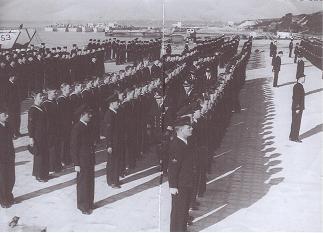
|
| This
Parade was held in Poole, Oct 1944, just prior
to leaving for Walcheren. This is the Support
Squadron Eastern Flank in entirety.
Unfortunately only a handful of men survived
the landing - 17 on LCH 269 and a few others.
The second officer (carrying out the
inspection) is Commander Kenneth "Monkey"
Sellars. |
It was October 1944, the ship's
company had been given a well-earned seven days leave. I
was relaxing at my fiancee's home in Leyton, London, the
fireplace giving out a comfortable warmth. We were playing
cards. It was around eight p.m., a knock came on the front
door, Anne's Mother answered the door and returning, a
little pale, told me that a constable wished to talk with
me. I went out in the hall, the Policeman asked me if I
was Petty Officer Basil Woolf, and when I acknowledged, he
told me that I was to return to my ship immediately. The
reason for his personal visit, was the lack of a telephone
at Anne's house!
I packed at once, caught a bus
to Waterloo station and boarded the next train to Poole,
wondering, why the recall? I arrived back on the ship in
the early morning, and the ships crew were all asking
questions about the call back.
LCH 269 now had a new Skipper.
Commander Kenneth Sellars RN, a very high ranking officer
for a landing craft! He was mostly known as "Monkey"
Sellars and had been in pre-war days an international
rugby star. He was now taking over the command of the SSEF
which comprised twenty seven various types of landing
craft and approximately four hundred naval personnel. For
this operation he had an additional five hundred Royal
Naval Marines.
Lieutenant Commander Holdsworth
personally spoke to each crew member, wishing us all luck.
As he left the ship, he stood on the quayside and smartly
saluted us all. We were all sorry to see him go as he was
a fine officer and a real gentleman.
2. COMMANDER
KENNETH SELLARS RN - OUR SKIPPER
Commander Sellars was born on
August 11th 1906 in England, and when he was still a small
boy his family moved to South Africa. He did not return
until he joined the Navy in 1920, going first to the
Osborne Royal Naval College, and then to Dartmouth. His
term Master at Osborne, Captain Bob Cunliffe took one look
at him and immediately christened him "Monkey", a name
which he relished and adopted and which stayed with him
throughout his life. As a midshipman and sub lieutenant he
served in HMS Thunderer, Revenge, Repulse, Marlborough and
Walpole before going on to the Royal Naval College at
Greenwich for Sub Lieutenant courses.
After this he was appointed to
the Royal Yacht Victoria and Albert. It was during these
appointments that he played rugby, as full back for
England. In 1929 Sellars joined HMS Calcutta on the South
Africa Station and it was here that he met and married his
wife, Molly. In 1931 he returned to England, serving first
in "Wallflower" and then "Nelson" In 1935 he resigned and
retired from the Navy. He did this against the advice of
all his friends, and the personal opposition of his
Commander in Chief, Sir John Kelly. He joined a
stock-broking firm, but came back again at the outbreak of
the Second World War and went to Dartmouth as a term
officer.
In 1941 at Lord Mountbatten's
instigation, he was taken out of Dartmouth and sent to
Lamlash in Scotland for amphibious training in Combined
Operations. He commanded a squadron of landing craft
during the Invasion of Sicily, returning to England in
time for the Invasion of Europe in 1944.
On the sixth of June he
commanded the first flight of major landing craft at
Ouistreham on Sword Beach, the Support Squadron Eastern
Flank, and then became Senior Naval Officer "Sword Area".
He was awarded a DSC and promoted to Commander. Later that
year he led the assault on the island of Walcheren in the
Scheldt and for this he was awarded a DSO.
Sellars returned to
stock-broking after the war, becoming a member of the
Stock Exchange in 1946. He became senior partner of W. l.
Carr in 1957, retiring in 1969. He will also be remembered
as a rugby player and cricketer. In 1927 he won three caps
playing for England and three caps again a year later. He
also played for the Navy, for the Barbarians, and for
Blackheath. In 1982 after successive hip operations he and
his wife emigrated to South Africa, his wife died in 1984
and he died at the age of 82 in Cape Town. He was survived
by one son.
BATTLE
FOR WALCHEREN - OPERATION "INFATUATE"
(included
in Western Europe
June 1944-1945 - Campaign Summary)
3. POOLE
HARBOUR to BELGIUM in LCH.269
It was October the 28th 1944,
and I had orders to have main engines running at 0500
hours. Low clouds were moving across a grey dark sky. It
was not yet daylight, the damp cold air foreboded the
presence of the oncoming English winter. A stiff wind was
blowing. Whatever our destination, it was to be a rough
uncomfortable journey. Our landing craft, with their flat
bottomed hulls, were made for landing on beaches in
shallow water, and certainly not for long sea journeys!
We left Poole harbour and were
soon rolling and pitching in the heavy seas. We would soon
know where we were heading. At this point it was due east,
soon to pass the Isle of Wight off our starboard side. I
couldn't believe it! We were we returning to France! But
after a short time we changed direction and headed north
in the English Channel, our ship heaving and creaking in
the heavy swell, our decks awash, and huge seas breaking
over our bow.
During weather like this, all
crew members wore their regular oilskins and a safety belt
with an attached buckle to be hooked to a cable that
circled the ship. This saved them from being washed
overboard by large swells that swept over the decks. To go
from my cabin to the engine room or any other destination
on the ship usually involved getting drenched. Very
uncomfortable for the seamen, whose duties confined them
to the upper decks, but the engine room crew were able to
take off their wet clothes, dry out by the heat of the
engines, and usually kept a spare pair of overalls in a
locker, down below.
I stopped at the wheelhouse,
The coxswain was steering. The steering gear was unlike
the wheel usually associated with most ships. On this
landing craft the rudder was controlled electrically. A
small handle, not unlike a trolley or tram handle, would
turn the rudder from side to side. The coxswain sat on a
high fixed stool, with a seat belt, a necessity in high
seas. In front of him a dimly illuminated compass swung
with the movement of the craft requiring full attention to
keep the ship on course. In front and above was an
illuminated dial showing the amount of turn in degrees to
port or starboard. There were four portholes, covered at
night. It was definitely not a place to be in if you were
inclined to be claustrophobic. In this small space, the
movement of the craft, the eerie glow from the compass,
the odour of diesel fuel from the engines, could turn the
strongest stomachs. Above the wheelhouse was the bridge,
completely open to the elements, where they would convey
orders to the coxswain through a speaking tube, and with
double telegraphs for orders to the engine room.
The Coxswain told me that he
had received an order changing directions from the
northerly direction, and that we were now heading
northeast by east. He said "it looks like we are heading
for Belgium".
I returned to the engine room,
where in a small space we had eight 285hp Gray Marine
diesel engines, four to each propeller. Lubricating oil
had to be fed to the engines constantly, a tricky job in
this weather, using a funnel and gallon cans of
lubricating oil. In addition to the eight main engines,
there were two generators which supplied the electricity
to everything,. A rheostat on the electrical board was
constantly adjusted to keep the current at 110 volts for
the lights, heating, navigation, toilets, bathroom, bilge
pumps, and steering. The generators were vital to us, a
problem with the generators and we would all be "dead
ducks". Operating noise from the main engines and the
generators was intense
The engine room was below sea
level, no portholes. At the engine controls, the engine
noise was so deafening, we wore earplugs. The telephone
inter-communicating system was useless so I had devised a
communication system with the bridge, using a very loud
buzzer and a red light - a series of flashes on the red
light signified a number of orders from the bridge. For
instance, one buzz - raise speed by 25 revolutions, two
buzzes - lower speed by 25 revolutions. This worked very
efficiently. The engine operator sat at a console with
seat belts, with the telegraph system just about at eye
level, the throttles on the console, with the red light
just above the throttles. A constant sickening smell of
diesel oil, made a four hour watch just miserable.
4. STOPOVER
AT OSTEND
Orders came to slow speed. I
climbed above to get a look out and spotted land, we
slowly made our way into Ostend Harbour. The retreating
Germans had sunk many ships in the harbour to prevent
large ships entering with supplies for the Allies. We were
able to squeeze around the wrecks and finally tie up at a
dock. Everything was now still. We were able to walk about
without being thrown from side to side. We tied up and
shut down main engines. No one had the faintest idea what
we were doing in Ostend!
To the crew?s surprise, the
Skipper announced four hours shore leave, which was very
unusual as we were on active service. We were warned that
the Germans had mined all the roads and pathways leading
down to the harbour before they left. The Sappers had
cleared a path from the docks into the main street and
this was the only safe throughway, "keep to that path or
perish" was our final warning!
Top two pictures are LCH
269 tied up at dock in Ostend. LCH 185 is alongside,
she was sunk at Walcheren (gs ? according to HMSO
"British Vessels Lost at Sea" and Lenton's "British
and Empire Warships, LCH.185 was mined and sunk off
Normandy, 25 June 1944). Interesting to note, the
headquarters ships had the radar.
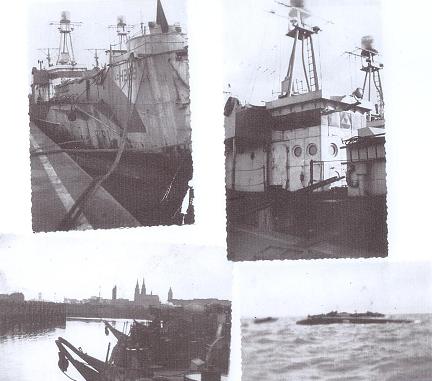
Bottom left, another
view of the sterns with Ostend in the background,
the other interesting fact, I stood on the dock
taking these pictures with a Kodak folding camera,
and nobody questioned me! I do remember I had one
roll of film, which was impossible to get during the
war. I don't remember where I got the film!!
The swept path was about four
feet wide, marked on both sides with small signs depicting
skull and crossbones. It led into a devastated ghostly
city, that had once been a thriving tourist resort.
On both sides of the main
street, buildings had been levelled. Small dark shops with
empty and broken windows, some boarded up, were desolate.
As I walked down the main street I felt sad for the people
that had lived and traded here and had now lost all their
possessions. The street was deserted, it was a ghost town.
I heard sounds of piano music
and singing coming from a bar in a side street. Men in
uniform were drinking local wine, no beer was available,
the bars had been ransacked by the retreating Germans.
There were one or two cafe's
where they were serving chips (french fries), no other
food being available, and a couple of my shipmates were
enjoying the food in the company of two ladies, who
appeared to have seen better times, sitting on their laps.
In the center of town I spotted
a large store. I walked I in to investigate and saw a
large number of glass showcases completely empty. However
by one of the cases a young woman was busy doing
something. I could not imagine why she was there with no
merchandise to sell. I asked if she spoke English, to
which she answered "yes". I then asked if there was
anything available such as a gift or souvenir that I could
buy to take home to my fiancée. She thought for a moment,
then went over to a large walk-in safe. Using the
combination she opened the door and I looked into a
completely empty vault except for a solitary, very small
bottle which she brought over for me to see. It was Chanel
21, I was happy to purchase such a valuable item from the
safe. It did indeed cost me a week?s pay!
I placed the bottle in my money
belt (government issue to all sailors), thanked the girl
and left the store.
The sailors in the bars were
really getting raucous, the cheap wine they were drinking
was taking effect. I was a little concerned as they had to
walk back to the ship along that four foot pathway. I
returned to the ship and reported my concerns to the first
lieutenant, who immediately stationed a couple of men
along the swept pathway to ensure the safety of the men.
All made it back safely, there were no casualties!
It was the 31st of October. I
sat at the table in our cabin, eating breakfast. The radio
was on the Armed Forces programme. Vera Lynn was singing
"The White Cliffs of Dover". How nice it would be to be
back in Blighty! We still had no idea where we were going,
or what we were about to do. Most of the day was spent in
routine engine maintenance, cleaning, etc.
5. HEADING
FOR WALCHEREN, FIRST and ONLY BRIEFING
The Skipper called for main
engines at 1900 hours. We started them at 1830 for a warm
up period. I entered his order in the log. At 1915 we
received the first telegraph order, We were on our way!
Just after midnight, November
1st 1944, we had left Ostend harbour and a few miles out
at sea, rendezvoused with the remainder of the Support
squadron. At 2100 hours all commissioned and
non-commissioned officers, seven in all, were instructed
to report for a briefing in the ward room. We were all
invited to sit around the table.
Around the wardroom bulkheads
were air photographic maps of an island coastline.
Commander Sellars entered the room and told us to remain
seated. He stood at the end of the room and said
"Gentlemen, this is Walcheren island". We all looked very
surprised as this was the first time we had ever heard of
the place! Commander Sellars continued to explain. "It is
located at the mouth of the river Scheldt. Like most Dutch
islands that are lower than sea level, it is dyked. It is
preventing our ships, by its heavy shelling, from entering
the Scheldt with supplies that could be unloaded at
Antwerp. The air force has attempted to damage the dykes
and flood the island, with the possibility that the
flooding has put some of the heavy fortified gun positions
out of action. However our sources tell us that these
heavy fortified gun positions are still operational. The
guns are in six and eight foot reinforced concrete
emplacements and are untouched by the bombing, and they
are extremely accurate. Our orders are to get onto the
beaches, and land our Royal Marine Commandos who will
systematically silence each gun position.
"Hitler has declared this
island a bastion, which means that his men are forbidden
to surrender, and will fight to the last man. The guns on
the island are various types. There are 3in anti-aircraft
guns, 5.9in (150mm) which have a high rate of fire and are
extremely accurate, numerous 88mm and 50mm are fully
operational (gs ? also 8.7in (220mm) and 4.1in (105mm)
guns). The beaches are heavily mined with booby
traps on underwater stakes, barbed wire completely
surrounds the beaches, which are strewn with thousands of
mines. He pointed to a 400 foot broken area of the dykes
and said " this is where we will land our Marines, a place
called Westkapelle."
"The island also has several
pads that are being used to launch the V2 rockets* on the
civilians in London. The island must be taken. It is
imperative that our supply ships get up the Scheldt to
Antwerp. General Patton is currently relying on supplies
to get to him by land all the way from Normandy. The
German army have retreated to the other side of the
Scheldt and are attempting to reinforce. The overthrow of
this bastion will give us victory and considerably shorten
this war.
* Many thanks to Jakko Westerbeke, 2 August 2013, for
the following
While looking for some information on WWII landing
craft today, I came across this very interesting
article. This has special interest for me, as I live on
the island and my grandfather's house, when I was a
child, was at the foot of the Westkapelle sea dyke, just
a few hundred metres from where the RAF had breached it
in 1944.
Walcheren was definitely used
for V2 launches (Gordon Smith had added a note
that they had not been based in Walcheren - source
long forgotten): six were fired from the vicinity
of a country house near the village of Serooskerke
from 15th through 18th September 1944. In fact, the
first photographs of the missile to make their way to
British intelligence were taken (in secret) by a
villager there when the convoy took a wrong turn and a
vehicle carrying a missile stopped in front of her
house. Two of these can be seen at
http://www.v2rocket.com/start/deployment/serooskerke-rijs.html.
"At the same time as our
landing takes place, a large scale attack will take place
at Breskens to our south, by British and Canadian commando
units, followed by British and Canadian Infantry units.
The landing by the SSEF is
supposed to coincide with a thousand bomber raid prior to
our landing on the beach, but I have been notified that
the weather is getting worse in England, and due to very
foggy conditions, the Royal Air Force will not be able to
participate. It is too late to change our plans at this
point. We are going in. It won?t be a piece of cake. We
will use anything at our disposal, even if it means going
in with small arms. Be prepared for a heavy bombardment by
our monitors, which will start some time before we hit the
beaches.
I wish you all the best of
luck, gentlemen. Touchdown for operation "INFATUATE" will
be 0900 November 1st.
6. IN TO
ACTION
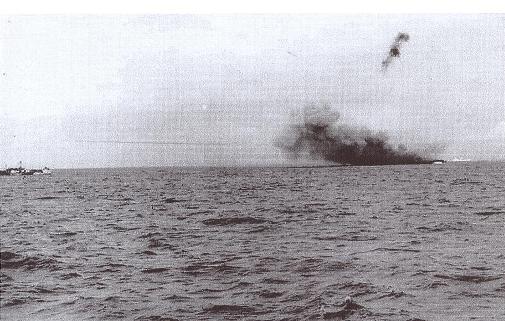
Landing craft hit. LCH
269 heading in to help
We headed north, and at 0440
hours course was altered to 056 degrees. The seas were
very heavy, under a grey miserable sky. At 0550 hours,
speed was increased to 6 1/2 knots and course altered to
041 degrees true. At 0645 hours "action stations" was
called and all hands took their positions. At 0700 hours
the coastline was clearly visible and at 0713 hrs the
tower on Westkapelle, on Walcheren was clearly seen.
At 0808 hrs, course was altered
to 079 degrees, the ships company continued closed-up on
"action stations". At 0809 the first fire came from the
Westkapelle batteries. They had spotted us!
The Naval bombardment started
with three large ships of the Royal Navy ? battleship WARSPITE
and monitors ROBERTS
and EREBUS.
The latter had one gun turret inoperable from damage
sustained at Normandy (gs ? believed to be HMS
Warspite as the two monitors only had one 15in turret
each), and at 0825 hours the Westkapelle battery
ceased to fire after receiving direct hits from the large
ship?s guns.
In our group of 27 landing
craft were three LCRs. These were tank landing craft that
had been adapted as rocket ships. The upper deck had
chutes for 1200 rockets, all fired by twelve volt
batteries. The bridge was protected by a large steel
flameshield. All the crew were positioned behind the
shield. These rockets when fired were able to clear a
beach of any living person for a quarter of a mile, as the
rockets would come down straight, like mortars. Slit
trenches would be of no use. The deck of the LCR would
glow red after ignition.
The three LCRs were coming up
behind the main group of landing craft heading for the
beach. A shell hit one of the LCRs directly on the
starboard side, the craft listed badly and pre-ignition
set off 1200 rockets that landed amongst the support
squadron. I have never heard explosions like that in all
my years of war! They appeared to go on for several
minutes, but in reality it was probably 45 seconds. We had
no ear protection, my stomach turned over, my ears rang
with the clamour. I could do nothing but clap my hands to
my ears and put my head down. From up above I could hear
screaming. Leaving one of my hands at the controls, I
climbed the stairs from the engine room to find out what
had happened, a necessary option as no one bothers with
the engine room staff. We are down in that hole like
troglodytes.
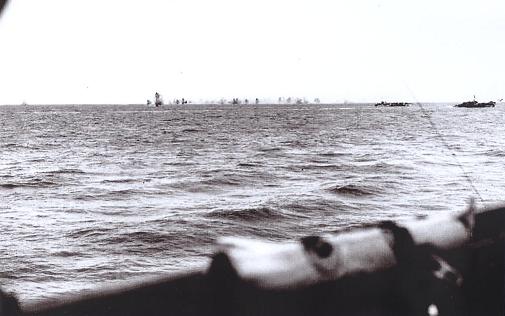
Bombardment and shelling,
LCH 269 on far right of the picture.
I saw landing craft burning and
sinking all around. The sea was on fire. Men were in the
water, some motionless, some attempting to swim. Our ship
was picking men out of the water, The welldeck was full of
injured sailors. Five of our craft were sunk by this
"friendly fire". Thirty sailors were injured.
(gs - From "The Campaign
in North-West Europe June 1944-1945", HMSO, 1994, page
49 ? "The Support Squadron had also opened fire but
though all its craft were being straddled or
near-missed by batteries W 11, W 15 and W 17, it was
not till 0920 that the first serious hit was
registered when L.C.F. 37 was severely damaged forward
by an enemy shell and eventually blew up. Shortly
after this the southern group also came under heavy
and accurate fire south of the 'kidney' shoal, but
though severely hit pressed home their attack with
unrelenting vigour. At 0934 L.C.T.(R) 334 fired her
ranging rocket salvos which fell short. Then she was
hit twice on her starboard side forward. By a stroke
of ill fortune this caused her to swing towards the
north and accidentally let go some of her rockets
which fell close to L.C.H.269. Unhappily rockets fired
by L.C.T.(R) 457 and L.C.T.(R) 378 also fell near
three of the supporting craft and on the port beam of
the L.C.I.(S)?s taking the Commando ashore. The
L.C.I.?s. at once turned away but resumed their course
towards the shore at increased speed ten minutes
later. Casualties in two of the three supporting craft
were thirty slightly wounded but the other, though
completely blotted out by the smoke of the exploding
rockets, fortunately suffered none. L.C.T.(R) 334
quickly resumed her firing course and with L.C.T.(R)
363 pressed on her attack with the utmost
determination although heavily hit.")
We took the wounded and dead
personnel to the hospital ship and returned to assault
zone. Landing craft were heading into the beaches with the
sea in turmoil from the incessant shelling. Small landing
craft were running parallel with the shoreline firing
their 20mm guns directly at the slits in the gun
emplacements. The ammunition being used was anti-personnel
which shattered into myriad's of shrapnel pieces inside
the gun positions.
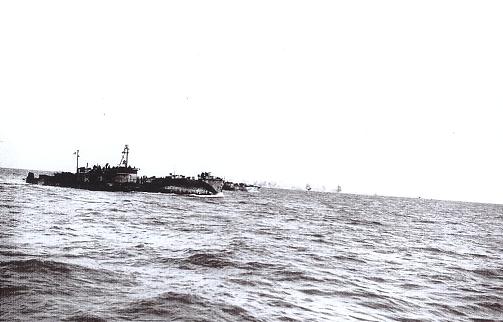
LCH 269 on
left.
The enemy fire was fierce, and
was systematically hitting the small craft approaching the
beach. One LCG, hit and on fire was abandoned on the
beach, other craft were burning, sinking and exploding.
With this heavy fire from the shore batteries, we were
being annihilated rapidly. Some craft had already reached
the gap in the dyke and were successfully landing the
Marine commandos. LCH 269 received a very close shell off
our stern, which really shook us up in the engine room.
Shrapnel caused several holes in our bulkheads, and sea
water spurted in. We used damage control plugs, conical
wood plugs, to stem the water, and got a call from
Commander Sellars asking if all engine room hands were OK?
He also asked about the engines. I reported that all was
fine. He said "for God?s sake keep those engines running".
Then LCH 269 received a direct
hit on the starboard bow. It shook us all. The ship heeled
to port. We were thrown on to the deck. Luckily no sailors
were in the vicinity of the bows. Nobody was hurt, other
than shaken up. No water came in, but it certainly could
not stay that way. The skipper called for damage control
parties. I was in that group. On investigating, we found
that the hole in the ship?s side was very jagged and a
simple patch would not work. Someone came up with the idea
of using our rolled up hammocks as a form of gasket. We
gathered all the hammocks from the ships company. Jammed
around the hole and with a large sheet of plywood forced
up against the hammocks by two by fours hammered in to the
other side of the bows, it was a very fine emergency
repair!
7. "FROM THE
EPIC OF WALCHEREN"
Previous experience had shown
that German Shore batteries could rarely resist the
temptation of concentrating their fire on any craft
attacking them. It was therefore a part of the plan that
the Support Squadron, which was under the command of
Commander K. A. Sellars and consisted of twenty seven
landing craft of various types should close the shore and
deliberately draw the enemy fire upon itself. This would
inevitably result in heavy casualties, but as it was hoped
that it would enable the assault forces to land with
comparative immunity, it was considered that so long as
the enemy made the fatal error of concentrating fire on
the Support Squadron, close action was justified and heavy
losses acceptable. In other words this was a suicide
operation. Commander Sellars, in his report on the action
said "It was early recognised that we were up against
formidable opposition, and that losses and damage were to
be expected in craft engaging shore batteries at close
range. It is considered that this was fully justified
because the Commandos got ashore well and lightly (sic?).
I considered that, so long as the Germans made the mistake
of concentrating their fire on the Support Squadron, close
action was justified and losses acceptable. In fact, I
decided that if there was signs of batteries selecting
incoming loaded L.C.T?s with troops as their primary
target, even closer action would be ordered so as to force
the Germans to fire on the Support Squadron." He also
added later, "There can have been few more gallant actions
in Naval history than the way in which the Support
Squadron drew the fire of the formidable German Batteries
on to itself and provided the assault forces with a
comparative safe conduct to the shore"
8. CAPTAIN A
F PUGSLEY'S REPORT - NAVAL FORCE COMMANDER
The following is an excerpt
from the report of Captain Pugsley who headed operation
"Infatuate". It was not the easiest of decisions. To say
execute might mean signing a death warrant for an entire
brigade of Commandos, their assault and Landing Craft and
the Support Squadron who were to escort them in". His
final injunction from (Admiral) Ramsey, (General)
Simmonds, and Foulkes (gs - service and rank not
known), his immediate Senior Officers, had been that
he should not proceed with the operation unless he was
facing opposition that was "not more than weak". At 0800
Captain Pugsley said there was certainly no evidence that
there was such a state of affairs.
The Germans found, to their
dismay that the large 88mm guns could not be lowered
enough against the craft closing in on the beach. However
the smaller guns were used and sank and damaged many
craft, causing heavy casualties.
(gs - From "The Campaign
in North-West Europe June 1944-1945", page 51 ? "The
Support Squadron had also suffered heavily for by 1230
only seven of its twenty-seven craft, including three
equipped for firing smoke only, remained completely
fit for action. The Squadron's state was:
Sunk or sinking - L.C.G
(L)?s 1 and 2, L.C.F. 37, L.C.G.(M)?s 101 and 102,
L.C.S.(L)?s 252, 256 and 258
On fire in the magazine
and abandoned - L.C.F. 38
Damaged and out of
action - L.C.G.(L)?s 11 and 17, L.C.T.(R)?s 334 and
363, L.C.M. 42 and 36, L.C.S.(L) 260
Damaged but capable of
further action - L.C.G.(L) 10, L.C.F.?s 35 and 32,
L.C.H. 98
Fit for action -
L.C.G.(L) 9, L.C.S.(L)?s 254 and 259, L.C.T.(R)?s
457, 331 and 378 (firing smoke only), L.C.H. 269
(Abbreviations: LC ?
Landing craft, G(L) ? gun (large), F ? flak, G(M)
? gun (medium), S(L) - Support (large), T(R) ?
tank (rockets), H ? headquarters)
As was only to be
expected, casualties among the officers and men of the
Squadron were also extremely heavy, 172 killed and 200
wounded, but their sacrifice had not been in vain for
it was under cover of the Squadron that the incoming
waves of landing craft had continued to beach so
successfully all the morning. There can be no doubt
that the Squadron's outstanding gallantry had done
much to make the seaborne landing possible and by 1230
the three Commandos were well established ashore.
Captain Pugsley now decided that all craft no longer
fit for action should return to Ostend.)
9. B.B.C. WAR
REPORT NUMBER 135
2nd November 1944
The battle continued for
several hours. On our ship a well known war
correspondent by the name of Dennis Johnston was
covering the operation for the B.B.C. I have a
transcript of his report as follows:
McLEOD: "Here in the studio
is a man from Walcheren?. our correspondent Denis
Johnston, who took part in the Naval side of the assault
on this island, the attack on German gun positions at
West Kapelle. Johnston left the coast of the continent
early this morning and, after a rough crossing, came
direct to London, he reached Broadcasting House only two
hours ago."
JOHNSTON: "They came down in
the belly of the Landing Craft, where we were all lying
curled up in the darkness, and told us if we came up now
we could see the beginning of the attack on Flushing.
This attack on the island was a three-pronged drive.
While the Canadians fought their way in from the
causeway, a second party was attacking across the
Scheldt from Breskens against the second of the little
humps that were all that was left of Walcheren ever
since the floods broke in. Our job - which was an all
Naval show - was to attack the western most tip - West
Kapelle - where the German batteries faced out to sea,
and a few thousand of the enemy were holding out on
another of these sodden hummocks of sand dunes
"Up on the bridge of the
Landing Craft we could see the red flashes of the guns
coming from the east over Flushing and directly in front
of us the dawn came up behind the light house tower of
West Kapelle. As it grew lighter, this armada of little
craft drew slowly in towards the coast.
"Our ship, LCH 269, was
leading. Behind us came a string of gun and rocket
carrying landing craft to cover the assault, which was
being made by the Marines. For a while there was no sign
of life at all on the shore, and we speculated as to
whether the enemy batteries had been knocked out already
by air attacks.
"But suddenly from here and
there along the beach came little yellow flashes of
light and we knew they were alive all right although we
couldn't see to begin with where their shells were
going.
"I don't think they saw us
for some time - the dawn was behind them, and we were
backed by a long line of scudding rain clouds, but as it
became fully daylight the covering craft moved forward
and closed with the batteries and the assault craft
moved up from behind and passed through heading for a
big gap in the dyke that we could see clearly not more
than a mile or so away.
"There was no question that
they saw us then. From all along the coast the enemy
batteries opened up on our fleet of ships, the shells
came whining overhead falling in the water with great
plumes of spray. But they were getting from us far more
than they were giving, and then from behind us came
hurtling the great shells of the battleship Warspite,
and from two monitor,s the Erebus and the Roberts
joining in the fight at long range.
"It was an incredible sight
to see those landing craft heading straight for the gap
in the dyke and passing through, while the little
gunships hugged the beaches and poured their fire into
the enemy caissons. The Marines fanned out behind the
gap and leapt ashore.
"On the far side there was
more flooding, so they had to land on the causeway
itself - on the concrete slopes of the causeway, and
fight their way in both directions along the narrow neck
of dry land that was all that was left of West Kapelle.
The enemy put up a smoke screen. Presently it was aided
by smoke from a fire in the lighthouse itself, as the
battle on the shore swept past it's base.
"The shelling of the little
ships by the batteries continued, and we waited
anxiously to see the enemy guns go out one by one as the
marines took the gun positions from the rear. It was
hard to tell what was going on but the reports from the
shore were good, although the men at sea were having a
very tough time. They seemed to present sitting targets
- most of those craft passing to and fro across the
front of the beaches, and here and there we watched them
being hit - pouring out smoke from their sterns, and in
one or two cases, going down on the shoals with only
their upper work showing, while the little personnel
craft dashed through and picked up the crews."
MaCLOUD: "From Breskens, on
the mainland, Guy Byam watched the Army Commando troop's
battle for Flushing across the narrow mouth of the
Scheldt. We are reading Byam's dispatch."
BYAM WRU: 8517 READER: "When
the Commandos had reached the fringes of the town, all
hell started to be let loose. Two batteries on either
side of Flushing ricocheted shells off the water amongst
the landing craft coming in with the following waves of
infantry, on beaches just to the West of the town, and
infilading machine gun fire caught the men as they came
ashore. From
where we stood we could see
these commandos had landed, right on the Harbour front.
Towering behind were the gantry's and cranes of
Flushing's shipyards and to the west, a little way out
of the town, was a large hotel right on the beach.
"This building was smashed
and torn apart by shells and, as I watched, the whole
front of it collapsed in a cloud of dust. Just below it
was the beach where the second unit had waded off the
assault craft, to get quickly into the area already held
by the commando's.
"Most of the dock area was
already in their hands and they were pushing on into the
fringes of the town. Our guns were engaging a battery of
German guns that were firing onto the beaches we hold.
"The whole of the dock area
of Flushing appeared to be on fire and bits of burning
paper came drifting back from over the water. Meanwhile
to the west another great fire was burning. It was smoke
from the town of West Kappelle."
MACLEOD: "West Kapelle in the
West.... Flushing on the south coast of the island?..
And, from the East came the third assault, that of the
Canadians, driving from South Beveland. Over all.
reports Alan Melville, pilots of the Second Tactical Air
Force flew to attack the German gun positions.
"That part of the TAF which
supports the Canadian Army's operations flew 240 sorties
yesterday. Today, as you know the beachheads are firmly
established and our forces have made good progress. But
this has not been an easy operation, nor has it been
carried out without loss.
"Here is Denis Johnston
again, (on LCH 269) to complete his story of the Naval
side of the landings with a description of the return
from Walcheren.?."
JOHNSTON LIVE: "We were now
on our way back with a hole in our side as big as a
window - a hole just above the water-line, patched up
with wood in some sort of way. And the Port side of the
bridge was peppered like a cannister.
"There were little heaps of
splintered wood and sodden mattresses in the forward
well, and down below - made as comfortable as they could
be in the circumstances - we were carrying the
casualties of three or four other craft - men collected
just as darkness fell, and the little ships rolled and
pitched alongside each other in the heavy ground swell.
"Outside in the wardroom
lobby, I noticed a cutting stuck up on the board which
read "Stop purring. The war isn't won yet"
"I think we knew that very
well. While the news from the beaches had steadily
improved all day, this had been, I think, to some extent
at the expense of the craft at sea. All day long they
had been under heavy and accurate shell-fire from those
batteries.
"A young naval lieutenant who
was sitting beside me dropped off to sleep on one of the
bunks - quite exhausted. He had commanded one of the
small motor craft known as L.C.P.(L)?s (gs - landing
craft, personnel (large)) and for fifteen hours
or more he and his crew had been marking shoals, laying
smoke screens and picking up survivors. In the end he
had lost his own craft and had come aboard ours. Before
closing his eyes, he dropped a casual remark that he had
enjoyed Dunkirk a great deal better.
"There were a lot of men in
that fleet who must have the same story to tell - the
men who took the Commandos in - the men who ran their
gunboats flat on to the beaches and engaged the shore
batteries at point blank range - the men of the Flak
ships who had turned their guns onto the enemy strong
point and literally plastered them with shells.
I shall never forget the
incredible sight of those salvoes of rockets as they
swept over the sea, and plunging down raised a long
drawn out inferno of smoke and dust, and spray, the like
of which I have never seen before on any battlefront."
Denis Johnston.
10. REPORT OF
PROCEDURE, OPERATION "INFATUATE"
In my research (Basil Woolf?s)
I was able to obtain a Report of Procedure for Operation
"Infatuate" the official name of the Walcheren operation,
from LCH 269. It is as follows:
(Enclosure No 3 to the
Commander, Support Squadron, Eastern Flank, letter No 1
162/94/1dated 14th November, 1944
FROM; THE COMMANDING OFFICER,
H.M L.C.H. 269.
DATE: 12th November, 1944.
TO: THE COMMANDER, SUPPORT SQUADRON, EASTERN FLANK,
H.M.S "SQUID"
REPORT OF
PROCEDURE- OPERATION "INFATUATE 11"'
(1) The ship weighed and
proceeded promptly at the time ordered namely, 0330,
November 1st, 1944, taking the lead of the convoy
composed of the craft of the Support Squadron, course
was 320 degrees true, Speed 6 knots.
(2) Course was altered at
0440 to 056 degrees true, and at 0445 the heavy
bombardment squadron was sighted to the Northward. At
0550 speed was increased to 6 1/2 knots, and at 0559
course was again altered to 041 degrees true. The ship's
company closed up to dawn action stations at 0645 and
secured for breakfast at 0718. At 0718 course was again
altered to 056 degrees true and at 0728 to 093 degrees.
(3) The Coast line had been
clearly visible from about 0700, and at 0713 Westkapelle
was clearly seen. At 0710 Domburg Battery was observed
to be active but no fall of shot was observed, and only
a few shots were fired. At 0750, Domburg Battery again
opened fire, and fall of shot was observed some distance
away. At 0750 the L.C.G of the Support Squadron began to
deploy.
(4) At 0808 course was
altered to 079 degrees and the ship's company again
closed up to Action Stations. At 0809 Westkapelle
Battery opened fire, and at 0815 the heavy bombardment
Squadron consisting of H.M.S. "WARSPITE",
"ROBERTS"
and "EREBUS"
opened fire. L.C.G opened fire at 0829. At 0825
Westkapelle Battery was observed to cease fire after
some direct hits, and shortly after the Hun attempted to
lay a smoke screen to close the gap.
(5) At 0845 L.C.H. 269 was in
position B.B. and remained in that vicinity to mark the
position for the first wave of Landing Craft, as the
M.L. originally in that position had to leave some time
before because of accurate shell fire. At 0909 small
calibre shells were observed to be dropping around us,
but none very close.
(6) At approximately 0915 we
proceeded slowly to the southwestward and thereafter
patrolled on orders of S.S.E.F who was on board, from
two or three miles off the coast, closing and
investigating damaged craft. Injured were brought
alongside by L.C.P.(L)?s several times, and at
approximately 1220 L.C.H. 98 came alongside and
casualties that had been placed aboard, were taken
aboard.
Shortly afterwards through a
break in the smoke screen the Hun turned his attention
to us and after a ranging shot that fell three cables
ahead and short, put one very close to our stern. No
casualties were obtained but splinters hit the ship in
many places. Full ahead was immediately passed and after
another couple of attempts, no further shells were
received.
(7) The ship then proceeded
out to the "KINGSMILL" (gs ? Captain-class frigate)
5 miles due West passing LCI (S) 532 burning and
abandoned at 1242. Shortly afterwards LCT 461, Hospital
carrier, was closed, but found to have been mined and
was already full. One Officer that had died on board was
disembarked, and after closing the "KINGSMILL", LCH 269
proceeded alongside another Hospital carrier and
disembarked the remaining wounded, "KINGSMILL" was once
again closed while there was a consultation between
S.S.E.F and NC Force T.
ENCLOSURE NO
THREE TO THE COMMANDER SUPPORT SQUADRON EASTERN FLANK,
LETTER NO 162/94/1 DATED 14TH NOVEMBER 1944.
(8) At 1800 "KINGSMILL"
anchored 1 mile further to the westward, and at 1830 LCH
269 anchored 10 cables due north from her. At 0320
reports were received of E.Boats and human torpedoes
some distance away, so Action Stations were sounded, and
as nothing developed they were later secured, at 0630
dawn action stations were exercised.
(9) The ship remained at
anchor until 1345 November 2nd, when anchor was weighed
and a course for Ostend* was set with what was left of
the Support Squadron in company arriving there at 1800.
(*Notes by Basil Woolf:
This was not so. We left Walcheren with the hospital
ship which hit a mine off the English coast and sank
with all hands. LCH 269 returned directly to Poole,
the only remnant of the S.S.E.F. Several damaged craft
went to Ostend, as they were not seaworthy enough to
make the trip to England)
(10) During the course of the
action, the ship?s company were at Action Stations and
conducted themselves accordingly and seemed to stand the
strain very well. The cook* however, let the ship down
badly in that he is liable to seasickness and had also
worked himself into a state of jitters, so as to be
useless when most needed, action is being taken to try
and have him relieved. Although not needed, the damage
control and first aid parties were on top line and I
believe them to be efficient.
(*Note: With regard to the
cook, he came to our ship just prior to our Walcheren
operation. He had transferred from the Army, and was
very excited with his galley, having had to cook on
field stoves before. As to his mental condition. I
cannot verify that, as we the engine room crew were on
duty for almost two days, and were down in the Engine
room, keeping the engines running and banging in the
wood plugs in the holes in the bulkheads, whenever
they came loose and allowed water to seep in!)
(11) During the run in, while
not reported, it was subsequently found that Radar, type
970 was being jammed by star jamming, but that the
coastline showed through plainly. It was roughly one
mile out although calibrated shortly before leaving
Southampton*.
(Note: The Lieutenant
states he set the compass when we left from
Southampton. We left from POOLE, he could have
possibly verified the compass setting from Southampton
when we passed it during the night.
(12) It is suggested that a
proper gyro compass is most necessary in a headquarters
ship. Although carefully swung prior to leaving, I
considered my compasses almost unreliable on sailing
from OSTEND.
(13) It is also suggested
that if, in future, headquarters ships are to be a sort
of casualty clearing station, carrying a doctor, some
definite space be fitted with a more convenient entrance
than the Troop Space at present used with an almost
vertical ladder leading down.
(Signed) T.F.Owen*
Lieutenant, R.C.N.V.R. Commanding Officer.
(*Note: I have been unable
to get any information about Lieutenant T. F.Owen
R.C.N.V.R. (Royal Canadian Navy Volunteer Reserve)
other than he came on board LCH. 269 for this
operation and he was (Jimmy the One) naval slang for
second in command.)
11. "LITTLE
SHIPS TACKLED THE SHORE GUNS"
London Daily Mirror
Nov 2 1944
Running unflinchingly and
directly into the fire of the mighty German shore
batteries on Walcheren island, small thin hulled British
amphibious support vessels fought a battle the like of
which sailors who were at Dieppe or Normandy had never
seen before.
There were heavy losses. The
little ships kept their guns hot until they went down or
were forced to retire with holes in their sides and
bleeding men on their decks.
Men on the ships, gunboats,
rocket ships, and other small craft had been told to
engage at point blank range, and knock out if possible,
the fixed German gun emplacements lining the dykes and
high ground near West Kapelle on the Western side of the
island.
They went in with all their
guns firing, troop laden craft went up behind them to
discharge their loads
With our ships some thousand
yards from shore the German guns opened up. Suddenly
fire belched aboard one, she swung around in the water,
another got a direct hit, another raced into the shore
with all her guns firing, and turned out again with a
single officer left on her bridge and holes in her
sides.
One gunboat went into the
shore, was hit, floundered, and made a last burst to the
shore.
The Headquartership LCH 269
was nearly blown out of the water three times, it was a
fight lasting nearly five hours.
During the fight, shells
bounced off many of the five and six foot thick German
gun emplacements without effect, until the Commandos
were landed, and cut open the gun emplacements with
flame throwers and grenades.
12. FROM THE
LONDON DAILY MAIL
November 2nd 1944
At Walcheren, bad weather
made air support impossible and the only "softening up"
was by Naval bombardment.
After this inadequate
preparation the little craft of the Close Support
Squadron, outranged and outgunned, forced their way
inshore in face of raking fire from enemy coastal guns,
many of six and eight inch calibre.
Those craft which survived
long enough to get within range, shot it out with the
coastal batteries and succeeded in silencing many of
them. Of the twenty five gun and support landing craft
taking part In the operation, nine were sunk and eight
badly damaged*. The Close Support Squadron suffered
heavy casualties. 172 killed and 200 wounded**.
(Notes by Basil Woolf: * By
the end of the operation, our ship, the only left,
limped into Poole harbour. Actual loss to the S.S.E.F.
were 28 ships. ** 280 men of the Royal Navy lost their
lives. Our ship returned with a crew of 18, and many
wounded men in our troop quarters.)
In his official report,
Captain Pugsley stated: "This success would not have
been achieved without the outstanding gallantry and
determination displayed by all the Officers and men of
the Support Squadron, under the command of Commander
K.A.Sellars, who led the attack and engaged the
extremely active enemy batteries, from 9am till 12.30
pm. The Support squadron continuously engaged the enemy
batteries, firstly in support of the landings and later
supporting the Commandos advance to the southward.
Their losses were heavy, but
they stuck to their job of engaging the enemy, thereby
drawing the enemies fire and enabling the landings to
proceed." (from "Operation Neptune" by Commander Kenneth
Edwards R.N.)
Basil Woolf's
Account - continued
13. AFTER THE
LANDINGS
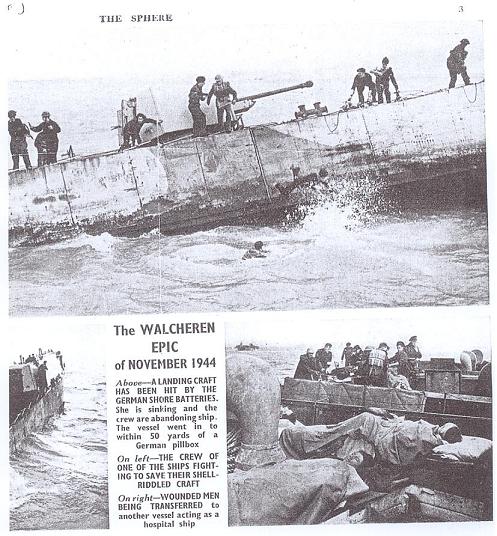
Pictures by
the "Sphere"
At dusk the shelling had
subsided, we were off the island wallowing in real heavy
seas. We did not know if the reason for the lack of
shelling was due to the marines or the dark or the fact
that there were no longer any more targets left. The
sudden quiet was eerie until the radar operators notified
the Skipper that five targets were spotted on the screen,
coming in from the north and heading in our general
direction. They were unable to fix the type of craft but
judging by their speed, they had to be torpedo boats, or
E. Boats. All hands were ordered on deck with rifles. Our
gunners manned the three Oerlikon 20 mm, the fourth on the
bow was out of action due to the shell that hit the craft
under the bow. We would not stand a chance against the
fast heavily armed boats but we were going to go down
fighting. The Radar operator reported another object that
was intercepting the five E. Boats, It was a British
destroyer which completely mutilated the fast craft, with
its heavier guns. Several were hit. They then turned tail
and raced back to where they had come from. The destroyer
signalled us "Good Luck LCH 269, signed Lieut Commander
Holdsworth" - our old skipper had saved our lives!
Our Skipper received a signal
that underwater one man submarines, and scuba units were
headed our way. Their purpose to attach magnetic charges
to our hulls. The orders were to set up watch teams around
the clock to throw charges into the water every three
minutes to kill or destroy the underwater menace by
compression explosion. We were up all night.
The underwater attack was
partially successful for when dawn broke we were all
aghast at the fact that only two ships from the SSEF had
survived, the hospital ship and us, seven others were
badly damaged and limped back to Ostend.
14. DEPARTURE
FROM WALCHEREN
We left Walcheren island. I
hoped never in my lifetime to see that island again. We
were two very sorry looking ships, making slow headway in
the still heavy seas, due to the large hole in our bow.
Damage control was still holding, but the sea could change
that in an instant. Weather reports were being received
that we were entering a strong weather condition, with
gales off the East coast of England. Our slow forward
movement could not compensate for the strong winds. We
were being forced off course, and consequently into the
English minefields. We had no charts for these as they
were top secret. We had charts of all the German
minefields, but these did not help our situation at all.
The Commander called for slow
ahead both engines, then signalled on the buzzer in the
engine room to drop the engine revolutions by 50
revolutions per minute. He sent a further message to drop
the engine revolutions to the minimum possible. We were
unable to record engine temperatures, as our gauges were
shattered by one of the near misses.
The Commander then made a very
unusual request - "bring your phonograph up to the
bridge", and a record I had which was a very popular song
at that time, "Tiptoe through the Tulips". He had it set
up and one of the seamen was given the job of winding and
replaying that record with the aid of a "Loud Hailer"
usually used when speaking to another ship nearby. We were
all in a state of trepidation. We could hit a mine at any
time. All the crew had removed their shoes and were
walking the decks with bare feet for fear a sonic mine
could be set off by heavy footsteps, and the Skipper was
up on the bridge playing music!
Just before dusk the hospital
ship hit the mine, I was on the upper deck at the time
having a break and a smoke, I was talking to another crew
member, the hospital ship was about a half mile off our
starboard side.
I saw the ship suddenly stop
her forward movement, shudder, then lift completely out of
the water amidships. She came down in two parts and sank
in a matter of seconds. All perished from that terrible
explosion. We moved over to where she had been, to pick up
any survivors. All were dead. They had not been in too
good a shape to start with. They didn't stand a chance. We
were the only ship left in that original flotilla of
thirty ships, I just could not believe that, how could
this happen? Would we now be next?
15. RETURN TO
POOLE HARBOUR
Sometime later, the Commander
informed us that we were out of the minefield. The weather
was horrible, our ship lurching and swaying drunkenly.
Everyone was feeling very miserable, I tried to sleep. I
woke up suddenly, everything was motionless. Was I in
heaven? I went up on deck. Our ship was limping into Poole
Harbour. We were in England and safe. I checked the money
belt around my waist. Believe it or not the small bottle
of Chanel 21 was still intact!
The Skipper decided to make a
collection on our ship for a remembrance of some sort
dedicated to the men that lost their lives on the
Walcheren landings. As there was only sixteen men left in
our the ships company, the amount collected was not very
great. The Skipper then made a very generous donation, and
after a discussion a temporary sign was decided on until
at a later date a Lychgate could be erected at a local
church. The sign would read as follows. '"WALCHEREN
MEMORIAL - a Lychgate will be erected on this site to
commemorate the men of the Royal Navy who fell at
Walcheren".
The operation was well
described by General Eisenhower as one of the most gallant
of the war. It was in the true "little ship" tradition.
All officers then went for a
de-briefing, and as the ship had gone in for repairs, we
were all given a well deserved leave. I immediately
removed the Chanel 21 from my money belt, gave it to Anne,
who, in all the excitement, accidentally dropped it on the
tiled hearth in her home. The house had a wonderful scent
of perfume for weeksI
16. IN SEARCH
OF A LYCHGATE BY EMAIL
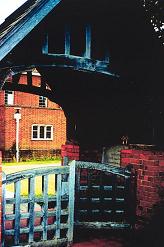 |
|
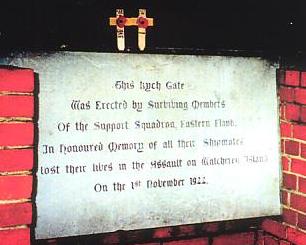 |
|
LCH
269 made a collection for a memorial to the
men who lost their lives. Commander Sellars
made a large donation, and a temporary
painted board was placed by the church
entrance. Later the Navy and Marine Corps
paid for a permanent Lychgate.
|
Many years later, my son, lan,
asked me to write my biography. I realized that I never
knew if the Walcheren memorial Lychgate was ever fulfilled
and if so, where?
It would not be difficult to
find out. With the help of the Internet, I contacted the
City of Poole by email, and shortly after received a reply
from Mr C. Barham the Churchwarden of St Michaels Church
in Hamworthy, a small village near Poole.
He wrote:
"One day in May 2000, the
Borough of Poole enquiry email address received a
request from a gentleman now residing in Florida, USA.
So the enquiry desk emailed Dai Watkins, the local
Studies Centre Manager at the Waterfront Museum, who
then emailed me.
"The request for information
by Basil Woolf (who was intending to visit the UK this
summer) was to discover where the Lychgate was that was
erected as a memorial to those who had lost their lives
on the assault on Walcheren island in November 1944. In
that assault, many ships were lost and hundreds of
sailors died. Basil's ship LCH 269 was the only survivor
and had limped back to Poole to be repaired and
refitted.
"Within two days of Basil's
enquiry, I was able, with help from one of my daughters,
to reply by email and also send an attachment of a
photograph of the Lychgate.
"Basil and his shipmates had
made a collection on their return to Poole, and had
donated the money for a memorial to those men in the
form of a Lychgate at a local church,
"In his next emailing to me,
Basil included a photo print of a notice stating the
intention to erect a Lychgate signed by the then Rector
of Hamworthy, the Reverend J.A.Kingham. It would appear
that St Michaels Church was chosen because of it's
proximity to HMS Turtle, now the Royal Marine Camp.
"This now gave me the
opportunity to do some detective work.
"By all accounts, one day
early in 1952, our former Rector, Canon Brian Aldis,
received a call from the Admiralty, informing him that
the survivors of the Walcheren operation wished to erect
a Lychgate. Later, Commander "Monkey" Sellars, who had
commanded the assault, visited Hamworthy with plans for
the design.
"Unfortunately, due to rising
costs, the sum raised by the survivors was insufficient
to pay for all the work involved. So the Parish agreed
to provide the concrete base, the brick pillars and the
curved approach wall, whilst the Royal Navy would supply
the oak woodwork and the two large stone memorial
tablets which local stonemasons would prepare.
"The original intention was
to place the Lychgate at the entrance to the old church,
but it seemed silly to do that if the new church was to
be built next door and so the gate was to become the
main entrance to the new church. Despite delays in
getting hold of suitable oak, the work proceeded rapidly
and by the summer of 1952 the Lychgate was complete.
"Then on a glorious sunny
day, on July 5th, the great unveiling and dedication
took place in front of a great crowd of local people,
naval personnel, with relatives and friends of the
fallen.
"First of all, the Bishop of
Salisbury dedicated the whole field as an extension of
the churchyard, and then with split second timing, the
Royal Marine Band marched up Blandford Road.
"The Admiral of the Fleet Sir
Phillp Vian, (Vian of HMS Cossack) came across from the
Rectory, accompanied by Commander Sellars and a
representative of the Dutch Embassy. Afterwards, over
two hundred or so relatives and friends crossed to the
Rectory Garden, where tea was laid on for them and many
old friendships were renewed and sorrows remembered as
they saw a fitting memorial to those they had lost. It
was a great day in the history of Hamworthy.
"Back to Basil Woolf. As luck
would have it, his nephew Michael who lives in
Bournemouth with his wife Susan, was able to bring Basil
and his wife Anne, to see the Lychgate for the first
time when they visited in July 2000. Harold Hudson of
the local branch of the Landing Craft Gunnery and Flak
Association was able to be present when Basil visited.
"I was pleased to meet Basil
in person, although we had emailed each other since his
first enquiry."
17. FINAL
WORDS
Most contemporary books on the
History of World War Two, do not even mention Walcheren in
their index!
Today my wife and I live in
Dunedin, Florida. We have a daughter Louise who is a
computer specialist, and lives nearby with her husband and
daughter Gabrielle. Our other daughter, Helen also lives
in Dunedin. Her daughter Hilary is in her second year of
college in Troy, Alabama. Our son lan, lives in Los
Angeles, and is a first assistant director, he and his
wife have two sons, one who is in his second year of
college.
Petty Officer Basil Woolf CMX
116402. May 2006.
POSTSCRIPT
Basil didn't tell
me he was Mentioned in Despatches for his part in the
Normandy landings. This only came out later in an email. I
am sure he won't mind if I mention it! - Gordon Smith
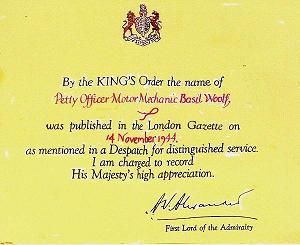
The
Continuing Story of LCH.269 into the 21st century
(1) An email
from Jim Mason (jhm5th@hotmail.com)
to Basil Woolf, 12 June 2007
Dear Mr. Woolf
It was with great interest that I read
your stirring account of "THE SUPPORT SQUADRON
EASTERN FLANK (S.S.E.F) and THE BATTLE FOR WALCHEREN
ISLAND, 1st November 1944" at http://www.naval-history.net/WW2Memoir-Walcheren.htm
. I had fortuitously "hit" it online when
searching for information on LCI(L)-269/LCH.269. I
have two questions for you: were you a member of the
commissioning crew of the LCIL-269, and did it also
take part in the Malta, Crete, Sicily and Italy
activities you mention in your memoir?
The reason for my interest is that I
believe your gallant little ship today rests rusting
on a mudflat in Atlantic City, NJ. If you copy
and paste the following coordinates into the "fly
to" function of Google Earth, the software will take
you directly to the location: 39 22? 34.64" N 74 27?
32.07" W . Some recent photos are also attached.
I recall climbing aboard this vessel
back in the '60's as a teenager. I believe it came
to rest here during the Great Northeast Storm of
March 1962. It had been moored across Beach
Thoroghfare at the end of Ohio Avenue previous to
that. There was a name board across the front of the
pilot house that read "QUAKER CITY". I later looked
this name up in the 1963 edition of "List of
Merchant Vessels of the United States", and found it
listed as a freight vessel registered in
Philadelphia. It was built in Barber, NJ, by the New
Jersey Shipbuilding Corp. in 1942 as the U.S.S.
LCI(L) [landing craft, infantry (large)]-269, and
and leased to the United Kingdom, 22 January 1943.
It was apparently repatriated to the US Navy on 20
March 1946, transferred to the Maritime Commission
for disposal, and sold on 28 January 1948.
I hope this information is of interest
to you. Thank you for recording your memories
for posterity.
Sincerely,
Jim Mason
and the photos,
courtesy, respectively, of Pictometry
International Corp (first two), Google Earth,
Chris Jahn (posted on the Google Earth
Transportation community forum)
(click on first three for larger images)
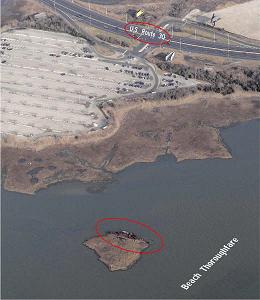
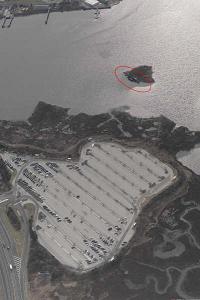
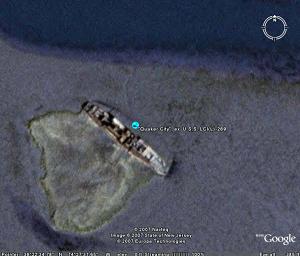
(2) Basil's
reply, the same day
Dear
Jim:
Thanks for your e-mail - this is quite
a puzzlement since my records show that LCH
269 was taken to the shipyard and scrapped somewhere
around 1947. It is quite possible that it was
purchased as a merchant vessel. You say it
had "Quaker City" on the front of the pilot
house. LCH 269 had the words "Sicily, Italy,
Walcheren" on the front of the Pilot house and three
aircraft that we shot down. If a private purchaser
bought the craft they could, of course, have painted
that out and replaced it with "Quaker City".
I did not commission this craft - I went to the USA
early in 1942 and commissioned LCI 175, if I remember
correctly - however, it all happened 65 years ago -
anyway, we sailed 175 across the Atlantic in January and
reached Gibralter 30 days later. Then we went
on to Dhidjelli, a small port in Algeria, to set up a
factory for repairing small craft in an old railway
workshop.
I later commissioned another craft, LCI 269 and we did
go to Malta to take food to the Island when the Italian
Navy surrendered. We took part in the Sicily
and Italy invasions, but did not land in those two
places. We finally returned to the U.K. and
became the headquarters ship of the Support Squadron
Eastern Flank. The rest of the story you know
from my Web site.
Do you recollect if the craft you saw in Atlantic City
had a tripod mast behind the pilot house? 269
had this for our radar installation but could have been
removed by a private owner.
Thanks for your interest and information. I
will forward this to a gentleman in Colorado who is at
present rebuilding an LCI. He may be
interested and possibly be able to get parts he needs,
providing they are salvageable.
Sincerely, Basil Woolf
(3) Basil
Woolf's email to Naval-History.Net, 13 June 2007
Dear Gordon,
What a surprise.
269 was sitting at the end of Ohio Avenue in Atlantic
city, until the great storm of march 1962, when it
apparently broke free and ended up on the mud flat, the
owner obviously walked away from the scene as it wasn't
financially valid for him to invest the money to salvage
her, or something like that!
I
had traced 269 to the year 1947 when it was
supposed to have been towed to the salvage yards and
scrapped, but it appears that a private owner or a
company may have purchased it at the junkyard, what do
you know about "Quaker City" I cannot find anything
relevant, as you know from my pictures, the front of the
Pilot house had "Sicily, Italy, Walcheren" and two
aircraft that we had shot down, however a private buyer
could have painted over this and placed "Quaker City"
there.
Jim
Mason asks if I was part of the commissioning crew, I
was not, his investigation shows that 269 was built in
New Jersey, I actually commissioned a craft in Norfolk
Virginia, and sailed it across the Atlantic in January,
I believe, 1943, I was assigned to 269 in
Djidjelli North Africa, and took part in delivering food
to the starving people of Malta, who were in dire need
as the Italian navy had surrendered there, and they
barely had enough food for their own people, we also
assisted in the invasions of Sicily, then Italy, and
shortly after we were summoned to the UK, where work was
done to transfer us to a headquarters-ship, and after a
short time took part in the Normandy landings, when we
became the head quarter ship of the Support Squadron
Eastern Flank.
You
have my permission to use this new information, however
I would like to check the following.
Was
Lch 269 berthed at the end of 1962 at Ohio Avenue,?
(someone in Atlantic City would have that information)
In
the storm of 1962, do the newspapers of Atlantic City
have a story of the craft breaking clear and finishing
up on the mud-flat?
Who
owned 269 at that time, and were they held responsible
for the salvage operation?
I
will try to get this info.
Basil
(4)
and Jim's reply to Basil, 13 June 2007
Dear
Basil,
I
would guess that the only way for us to
positively establish the identity of the
derelict vessel in question as LCI(L)-269 /
LCH-269 would be to delve into the records of
the Maritime Commission and/or the Philadelphia
Customs House, stored in the National Archives.
I personally am not prepared to take on that
daunting task!
However,
I would point out to you that the case for this
vessel being the former LCI(L)-269 would seem
fairly strong, circumstantially. Firstly, by its
configuration, it most definitely had been built
as an LCI(L). Secondly, at the time I recall
visiting it and observing the name board "QUAKER
CITY" on its pilot house, there was only one
vessel registered in the U.S. bearing that name.
The official listing of that vessel in the 1963
list of registered vessels published by the
Department of the Treasury, Bureau of Customs,
shows its former name to have been "LCI(L)-269",
with its port of registry being Philadelphia.
[Philadelphia would have been the port of
registry for any registered vessel owned in
Southern New Jersey.] Given the penalties
likely in effect for providing false information
to the Bureau of Customs when registering a
vessel, let alone the probable requirement for
providing a chain of ownership, one would be led
to assume that the published information is
accurate.
I
don?t recall the vessel having any type of mast
at the time that I first became aware of it. I
don?t believe it had a square inch of paint on
any exterior surface, either, other than the
mounted name board. Her hard-won emblazoned
battle honors would have long ago vanished --
"Sic transit gloria mundi." She was most likely
in the process of being stripped of usable parts
and materials when she was torn from her
moorings by the 1962 storm and deposited in her
present location. I don?t believe there is much
of anything left salvageable on her at this late
date. Her 1/4" steel plates are slowly
disintegrating in the salt water environment,
and soon she will have completely collapsed in
on herself.
Switching
gears, you mentioned that the LCH-269 was
credited with downing 3 enemy aircraft. I assume
this was in the Med? What were the
circumstances? Did you return to the States to
commission the LCI(L)-269?
Someone
is rebuilding an LCI in Colorado? How?d he get
it there?!
Finally,
if, after all those hours spent in LCI engine
rooms, you didn?t get enough of the sound of
eight running GM 6-71 diesels, you can hear them
again at the following site, run by an engineer
for the Circle Line of Manhattan, which operates
3 former LCI?s, one of which retains its
original double-quad power plant! Http://members.aol.com/lci191/LCI-191.htm
The links to the engine sound files are near the
bottom of the page--enjoy!
Sincerely,
Jim
Mason
and
I'm sure the story isn't finished yet .....